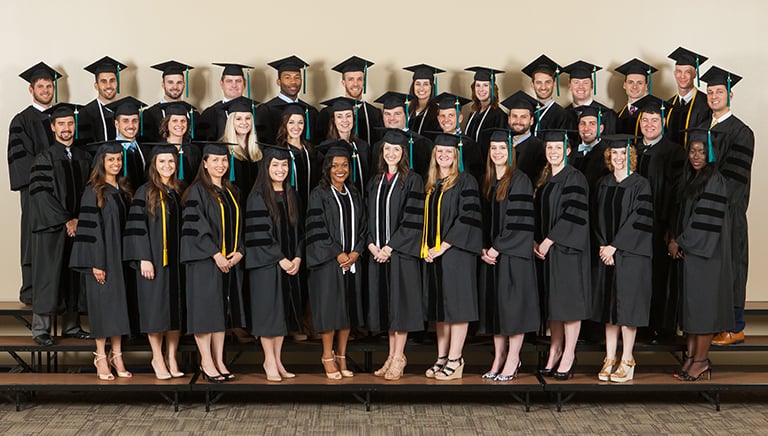
If you’re looking for a career that allows you to help individuals improve their daily lives in meaningful and creative ways, occupational therapy may be right for you.
As a registered occupational therapist (OTR), you may work with individuals or groups dealing with all types of physical and mental injuries and disabilities. Your role will be to aid in recovery and help individuals master vital living skills and navigate the world more independently.
Let’s take a look at what you need to become an OTR, how to get into occupational therapy school and the benefits of this profession.
What Degree Do You Need to Become an Occupational Therapist?
What are the education requirements needed to pursue a career in OT? Occupational therapy generally requires a graduate degree, either master’s or doctoral.
To work in the field, you’ll need to:1
- Complete either a master’s or doctoral degree in occupational therapy
- Attend a program accredited by the Accreditation Council for Occupational Therapy Education (ACOTE)
- Pass the National Board of Certification in Occupational Therapy (NBCOT) exam
- Become licensed by your state board
Once you’ve completed these steps, you’ll be able to work with the professional title of Occupational Therapist (OT) or OTR and maintain your license with continuing education credits.
To move into specialized occupational therapy roles, you may need to earn an advanced certification from AOTA or another credentialing agency. These positions generally require a combination of targeted experience and continuing education coursework.
Requirements for Admission to an Occupational Therapy Program
There are a few different routes to enter a graduate studies program, depending on your educational and professional experience.
For a traditional Master of Occupational Therapy (MOT) or Doctor of Occupational Therapy (OTD) degree program, you’ll need:2
- A bachelor’s degree from a regionally accredited school, often with a minimum GPA and/or in a healthcare field
- Undergraduate coursework such as anatomy, sociology, anthropology and physiology3
- A background check, including fingerprints and a drug screening. Please note, this is required prior to matriculation; and cannot be required for admissions.4
OT Programs may also require:
- Work, volunteer or observation experience in an occupational therapy setting
- An essay or statement of purpose related to professional goals and experience
- Professional references
Some schools also offer a nontraditional track for students who haven’t completed an undergraduate degree, allowing them to earn bachelor’s and MOT degrees in a dual program track.
How Long Is Occupational Therapy School?
When you apply to an occupational therapy program, you’ll need to decide whether to attend on a full- or part-time basis. This choice can determine the length of your graduate program. Programs also vary between schools, but you can plan on the following averages:5
- Master of Occupational Therapy (MOT) – Residential is two years, and flex is 3.
- Doctor of Occupational Therapy (OTD) – Resientails is 2.7 years, and flex is 3.7.
The length of time it takes to complete an OT program may also vary depending on:
- Online or residential program choice, and if travel is required
- If you need to make up any prerequisite coursework before starting a program
- Your progress through coursework, any credits you transfer and other academic factors
- Life considerations, such as if you work full- or part-time while earning your degree
Note that all programs also include at least 24 weeks of supervised clinical fieldwork.6
What Is the Difference Between MOT and OTD?
While you can enter the profession through either a master’s or doctoral degree in occupational therapy, the two aren’t necessarily sequential—you don’t need to complete a master’s first and then move on to a doctoral degree.
If you’re starting with a bachelor’s degree, you’re essentially choosing between two options:7
- An MOT prepares you to begin practical work in the field
- An OTD also prepares you for leadership, teaching and policymaking positions

Common Career Paths for Occupational Therapists
So, what will you actually do as an OTR? If you work one-on-one with patients, you will:8
- Review their medical history, ask questions and observe
- Evaluate their condition and needs
- Develop a treatment plan with specific goals and activities
- Assess and record their activities and progress
- Communicate and coordinate with other care team members
Individual patient treatment may also entail:
- ADL assistance – Help people learn, relearn and complete activities of daily living (ADLs) such as feeding, bathing, dressing and grooming oneself, work, homemaking and leisure
- Education – Teach individuals and their supporting family members methods of care and accommodation, including physical exercises and chronic condition maintenance
- Equipment and technology – Recommend and teach the use of equipment to aid in mobility, comfort and ADLs, such as leg braces, wheelchairs and eating aids
- Environmental adaptation – Evaluate the patient’s home or workplace to identify improvement needs, such as adding labels to help with memory, reducing fall hazards, etc.
Some OTRs work with groups or as consultants in settings where they assist with needs beyond a single patient. As an OTR, you may:
- Work in schools to modify equipment and activities for wider participation and access
- Evaluate and adapt workspaces to suit employees with unique needs
- Teach skills in a group environment, such as mental health and recovery facilities
- Manage occupational therapy assistants and aides and oversee treatment plans
Five Reasons to Pursue a Career in Occupational Therapy
Still wondering whether a career in occupational therapy is right for you? While a postgraduate degree is a serious commitment, the return on your investment could be high with the potential for excellent income, adventure, flexibility and personal satisfaction.
#1 Earning Potential
You have the potential to be set up to earn a comfortable living with a career in occupational therapy. The median pay for OTRs in 2021 was $85,570 per year, but opportunities continue to rise.9 Based on 2021 data for median pay:
- OTRs at hospitals: $95,590
- OTRs in-home healthcare services: $98,700
- OTRs at skilled nursing facilities: $98,390
- The highest-paid 10% of OTRs earned over $123,840
Your salary range can grow with experience and seniority, and may vary based on:
- Type of facility or environment
- Specialization and accreditations
- Location (both actual pay and income relative to local cost of living)
- Choosing a master’s or doctoral program
Another key consideration is the area where you live and work. The five highest-earning states for OTRS, along with their average annual salaries, are:
- Nevada: $109,01010
- California: $105,760
- New Jersey: $100,140
- Texas: $96,100
- New Mexico: $95,060
Remember to keep the cost of living in mind. For instance, while Nevada’s cost of living is about 10% above the national average, California’s is almost 50% above average—that puts Nevada in the #1 spot by a long shot.11,12
#2 Range of Specialization
In addition to selecting a work environment, such as hospital vs. home care, you can choose from a range of specialized roles and patient populations as an OTR. There are many certification options to pursue after earning a degree, including:
- Certified Aging in Place Specialist (CAPS)13
- Aquatic Therapeutic Exercise Certification (ATRIC)
- Assistive Technology Professional (ATP)
- Certified Autism Specialist (CAS)
- Certified Brain Injury Specialist (CBIS)
- Certified Diabetes Care and Education Specialist (CDCES)
- Certified Driver Rehabilitation Specialist (CDRS)
- Environmental Modification (SCEM or SCEM-A)
- Feeding, Eating, and Swallowing (SCFES or SCFES-A)14
- Board Certification in Gerontology (BCG)
- Certified Hand Therapist (CHT)
- Certified Industrial Ergonomic Evaluator (CIEE) or Certified Industrial Rehabilitation Specialist (CIRS)
- Certified Kinesio Taping Practitioner (CKTP)
- Specialty Certification in Low Vision (SCLV or SCLV-A) or Certified Low Vision Therapist (CLVT)
- Certified Lymphedema Therapist (CLT)
- Board Certification in Mental Health (BCMH)
- Certified Neuro Specialist (CNS) or Neuro-Developmental Treatment Certification (C/NDT)
- Board Certification in Pediatrics (BCP)
- Board Certification in Physical Rehabilitation (BCPR)
- Certified Psychiatric Rehabilitation Practitioner (CPRP)
- Specialty Certification in School Systems (SCSS or SCSS-A)
- Assistive Technology Professional (ATP) or Seating and Mobility Specialist (SMS)
- Certified Stroke Rehabilitation Specialist (CSRS)
If you want to better the lives of individuals in a specific area, it’s likely that there’s an occupational therapy specialization where your skills can be used.
#3 Availability of Jobs
Compared to a 5% growth rate for all professions, the Bureau of Labor Statistics (BLS) predicts a much higher growth rate of 14% for occupational therapists between 2021 and 2031.15
That growth will equal about 10,100 annual job openings for OTRs, including both role replacement and new positions. While your job opportunities and hiring potential can vary depending on your specific circumstances, becoming an OTR can set you up in a profession that will have ample job listings to choose from.


A multi ethnic group of doctors and nurses are in a meeting together. They are in a board room at the hospital. A female doctor is talking and her colleagues are listening to her.
#4 Job Satisfaction
Occupational therapy is a profession with the potential for high job satisfaction.16 The ability to opt for a career that keeps you moving instead of sitting behind a desk is a plus for many. The opportunity to hone your skills with a patient group and in an environment that you enjoy can be fulfilling.
If you have these skills, you may be best suited to work as an OTR:17
- Patience
- Excellent listening, communication and interpersonal skills
- Adaptability and creativity
- Compassion and empathy
#5 Travel Positions as an OTR
Occupational therapy is a healthcare profession with an established travel option.18 You can apply with an agency to select short-term openings across the country. Travel positions provide:
- Higher-than-average pay to cover employee leaves and shortages
- Travel and housing allowance or subsidy
- Ongoing healthcare and other benefits through the placement agency
- The ability to visit dream locations and fulfil vacation goals
- The opportunity to test out potential destinations for a permanent move
Occupational Therapists vs. Nursing Practitioners
Of all the health professions, OTs and nurse practitioners both focus on hands-on patient care. However, the roles have key differences. Perhaps the biggest is some of the prerequisite courses for each path. For example, with occupational therapy, you might have to take health sciences, kinesiology and biology. With nursing, the prerequisite courses depend on if it’s an LPN, ADN or MSN program. What is an MSN degree? Short for Master of Science in Nursing, it is a nursing program for registered nurses aiming to advance their careers by choosing a nursing speciality, potentially leading to a higher MSN degree salary. If you have a speciality in mind, check if it falls under an OT or nursing program.
Take the Next Step Toward a Career in Occupational Therapy
Wondering how to get into occupational therapy school? The University of St. Augustine for Health Sciences (USAHS) offers three OT degree programs: Master of Occupational Therapy (MOT), Doctor of Occupational Therapy (OTD) and Post-Professional Doctor of Occupational Therapy (PPOTD).
You’ll learn anatomy with high-tech tools, practice with mock patients in state-of-the-art simulation centers and prepare for clinical practice with patients of all ages. Our postgraduate degree programs also prepare you to practice leadership, policymaking, advocacy and research.
Choose the Residential or Flex (weekend-focused) format or the online PPOTD program for working clinicians and healthcare educators.
Ready to learn more? Explore our programs online or request more information on how you can further your passion for patient care.
Sources:
- “Become an occupational therapy practitioner,” American Occupational Therapy Association, https://www.aota.org/career/become-an-ot-ota
- “Program admissions criteria and formats,” American Occupational Therapy Association, https://www.aota.org/career/become-an-ot-ota/start-your-career-journey/program-admissions-and-formats
- James Mielke, “Getting into Occupational Therapy School: An Admissions Guide,” EduMed, last modified December 2021, https://www.edumed.org/online-schools/occupational-therapy-programs/admissions/
- “Master of Occupational Therapy (MOT) Program,” University of St. Augustine for Health Sciences, https://www.usa.edu/college-of-rehabilitative-sciences/master-occupational-therapy-mot/#admissions
- “How to Become an Occupational Therapist – Benefits & Job Opportunities,” University of St. Augustine for Health Sciences, last modified February 2022, https://www.usa.edu/blog/how-to-become-an-occupational-therapist/
- “Occupational Therapists: How to Become an Occupational Therapist,” U.S. Bureau of Labor Statistics, last updated September 8, 2022. https://www.bls.gov/ooh/healthcare/occupational-therapists.htm#tab-4
- “How to Become an Occupational Therapist – Benefits & Job Opportunities,” University of St. Augustine for Health Sciences, last modified February 2022, https://www.usa.edu/blog/how-to-become-an-occupational-therapist/
- “How to Become an Occupational Therapist – Benefits & Job Opportunities,” University of St. Augustine for Health Sciences, last modified February 2022, https://www.usa.edu/blog/how-to-become-an-occupational-therapist/
- “Occupational Therapists,” U.S. Bureau of Labor Statistics, last updated September 8, 2022. https://www.bls.gov/ooh/healthcare/occupational-therapists.htm#tab-5
- “Occupational Employment and Wages, May 2021,” U.S. Bureau of Labor Statistics, last updated May 2021. https://www.bls.gov/oes/current/oes291122.htm
- “Cost of Living in Nevada,” Best Places. https://www.bestplaces.net/cost_of_living/state/nevada
- “Cost of Living in California,” Best Places. https://www.bestplaces.net/cost_of_living/state/california
- Sarah Lyon, OTR/L, “30+ OT Certifications and Specialties,” OT Potential, last modified July 8, 2022. https://otpotential.com/blog/where-to-go-ot-degree
- Meredith Chandler OTR/L, “20 Occupational Therapy Specialties to Advance Your Career,” My OT Spot, last modified February 8, 2021. https://www.myotspot.com/occupational-therapy-specialties/
- “Occupational Therapists,” Bureau of Labor Statistics, last modified September 8, 2022. https://www.bls.gov/ooh/healthcare/occupational-therapists.htm
- 16. Sanna-Maria Mertala et al, “Job Satisfaction among Occupational Therapy Practitioners: A Systematic Review of Quantitative Studies,” Occupational Therapy In Health Care, last modified August 2021. https://www.tandfonline.com/doi/full/10.1080/07380577.2021.1964146
- “Occupational Therapists: How to Become an Occupational Therapist,” U.S. Bureau of Labor Statistics, last updated September 8, 2022. https://www.bls.gov/ooh/healthcare/occupational-therapists.htm#tab-4
- Sarah Lyon, “The Nitty-Gritty of Traveling OT Positions,” OT Potential, last modified March 2021, https://otpotential.com/blog/traveling-occupational-therapy








